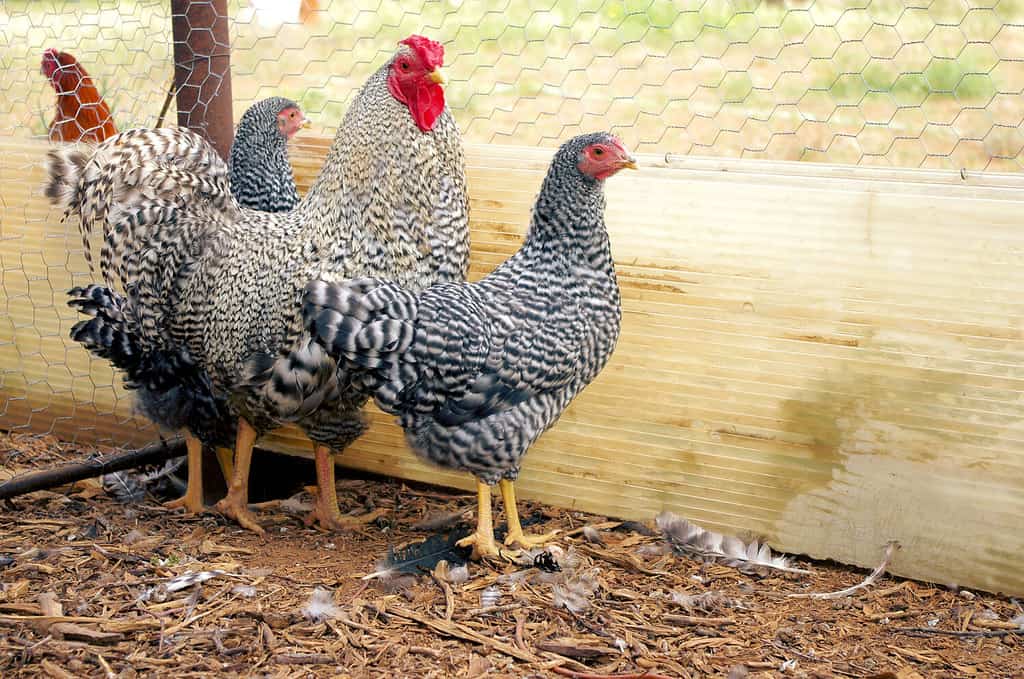Dominique chickens originated in the United States during the colonial period, making them one of the oldest recognized breeds in America. They’re known mostly for their unique, attractive color pattern, “barred.” Simply put, their feathers alternate between dark and light stripes.
Generally speaking, these chickens are medium-sized. However, their size does depend on their gender. That’s not the only difference, either. Roosters and hens also have different temperaments, for instance.
In this article, we’ll take a look at the main differences between Dominique hens vs. roosters.
Size Differences
There is a significant size difference between roosters and hens. Roosters are typically more robust and larger than hens. They also have a larger comb and wattles, which help signal them as males. Their tail feathers are also more prominent and longer.
On the other hand, Dominique hens are often smaller and more compact than roosters. They have a more streamlined appearance and shorter tail feathers compared to roosters.
Therefore, you can usually tell females and males apart pretty easily. This species has tons of appearance differences from gender to gender.
Temperament
Males and females also have some temperament differences. For instance, males tend to be territorial and protective. Therefore, they may exhibit more behaviors like crowing, fluffing, and similar territorial behaviors. Some roosters are even aggressive, especially if they feel threatened.
Generally, roosters are much more aggressive than hens.
On the other hand, hens are more docile and calm. They are more focused on foraging and nesting instead of keeping an eye on the rest of the flock. Furthermore, hens are much less likely to display aggressive behaviors compared to roosters.
Colors and Patterns
Dominique roosters typically have more vibrant and contrasting color patterns. They often exhibit a striking black-and-white “barred” pattern. Their feathers alternate between black and white stripes, creating a distinctive and eye-catching appearance.
In fact, it’s this appearance that sets this breed apart from others.
Hens have the same barred pattern, but it is typically less pronounced than in roosters. Their coloration tends to be more subdued and provides better camouflage. This pattern is one way they protect themselves from predators.
Dominique Rooster vs. Hens
Simply put, the main differences between Dominique roosters and hens come in their size, temperament, and color pattern. Roosters are larger and more protective. They also have more vibrant color and pattern differences.
On the other hand, hens are smaller and more docile. They usually have less contrasting colors as they try to blend into their surroundings.
However, individual variation does exist in this breed. Not all roosters and hens perfectly fit these descriptions.
Dominique Egg Quality

Historically, this breed was dual-purposed, so it produced both eggs and meat.
©The Jungle Explorer/Shutterstock.com
Of course, one obvious difference is that hens produce eggs. These hens typically lay medium-sized eggs, but this can vary from chicken to chicken. Their eggs are usually brown, though the exact shade does vary quite a bit.
Beyond that, these eggs are similar to any other chicken. The shells of the Dominique eggs are strong and durable. Their diet shapes the flavor of their egg a lot. When chickens are allowed to forage for insects and protein-rich foods, they tend to have richer-tasting eggs.
The nutritional content of their eggs is similar to other chickens, but it also depends on what they eat. The quality of the eggs relies strongly on the quality of their diet.
Dominique Meat Quality
Roosters are used to fertilize eggs but are also killed for meat. Historically, this breed was dual-purposed, meaning the chickens were utilized for eggs and meat. They are not a meat-focused breed, but they do still produce meat (as you might imagine).
The texture of meat from Dominique chickens is generally leaner than meat from breeds specifically bred for meat production. This can result in a firmer texture, which some people prefer. The meat’s flavor depends on the bird’s diet, but it tends to have a stronger flavor than traditional meat.
These chickens do not produce as much meat as some other breeds, as they are not very large. However, many still raise roosters for meat despite the yield per bird being less than other chicken breeds.
The meat of this chicken generally needs to have moisture added, as it can dry out easily. Brining and marinating are recommended to add some moisture to the meat.
Generally, this chicken isn’t a great option for those looking for a meat-focused breed. However, their meat is still absolutely edible and a nice by-product of owning these chickens.
The photo featured at the top of this post is © The Jungle Explorer/Shutterstock.com
Thank you for reading! Have some feedback for us? Contact the AZ Animals editorial team.







